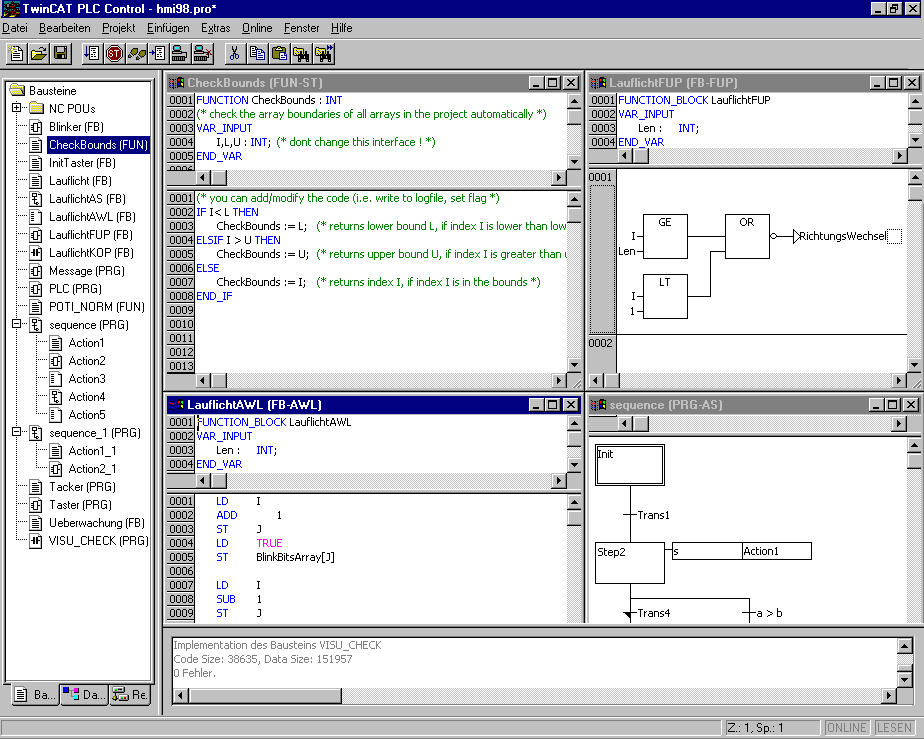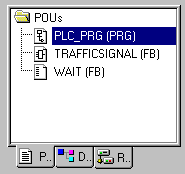The Main Window

The following elements are found in the main window of TwinCAT PLC Control (from top to bottom):
- The menu bar
- The tool bar (optional); with buttons for faster selection of menu commands.
- The Object Organizer with register cards for POUs, Data types, and Ressources
- A vertical screen divider between the Object Organizer and the Work space of TwinCAT PLC Control
- The Work space in which the editor windows are located
- The message window (optional)
- The Status bar (optional); with information about the current status of the project
Menu bar
The menu bar is located at the upper edge of the main window. It contains all menu commands.

Tool bar
By clicking with the mouse on a symbol you can select a menu command more quickly. The choice of the available symbols automatically adapts itself to the active window. The command is only carried out when the mouse button is pressed on the symbol and then released. If you hold the mouse pointer for a short time on a symbol in the tool bar, then the name of the symbol is shown in a Tooltip. In order to see a description of each symbol on the tool bar, select in Help the editor about which you want information and click on the tool bar symbol in which you are interested. The display of the tool bar is optional (see "Project" "Options" category Desktop).

Object Organizer
The Object Organizer is always located on the left side of TwinCAT PLC Control. At the bottom there are four register cards with symbols for the four types of objects POUs, Data types, and Ressources. In order to change between the respective object types click with the mouse on the corresponding register card or use the left or right arrow key.
You will learn in chapter Objects, how to work with the objects in the Object Organizer.

Object Organizer
Screen divider
The screen divider is the border between two non-overlapping windows. In TwinCAT PLC Control there are screen dividers between the Object Organizer and the Work space of the main window, between the interface (declaration part) and the implementation (instruction part) of POUs and between the Work space and the message window.
You can move the screen divider with the mouse pointer. You do this by moving the mouse with the left mouse button pressed.
Make sure the the screen divider always remains at its absolute position, even when the window size has been changed. If it seems that the screen divider is no longer present, then simply enlarge your window.
Work space
The Work space is located on the right side of the main window in TwinCAT PLC Control. All editors for objects and the library manager are opened in this area. You find the description of the editors in the chapter Editors in TwinCAT PLC Control, The Ressources, and Library Manager. Under the menu item "Window" you find all commands for window management.
Message window
The message window is separated by a screen divider underneath the work space in the main window. It contains all messages from the previous compilations, checks , or comparisons. If you doubleclick with the mouse in the message window on a message or press <Enter>, the editor opens with the object. The relevant line of the object is selected. With the commands "Edit" "Next error" and "Edit" "Previous error" you can can quickly jump between the error messages. The display of the message window is optional (see "Window" "Messages").
Status bar
The status bar at the bottom of the window frame of the main window in TwinCAT PLC Control gives you information about the current project and about menu commands. If an item is relevant, then the concept appears on the right side of the status bar in black script, otherwise in gray script. When you are working in online mode, the concept Online appears in black script. If you are working in the offline mode it appears in gray script. In Online mode you can see from the status bar whether you are in the simulation (SIM), the program is being processed (RUNS), a breakpoint is set (BP), or variables are being forced (FORCE).
With text editor the line and column number of the current cursor position is indicated (e.g. Line:5, Col.:11). If you have chosen a menu command but haven't yet confirmed it, then a short description appears in the status bar. The display of the statusbar is optional (see "Project" "Options" category Desktop).
Context menu Shortcut: <Shift>+<F10>
Instead of using the menu bar for executing a command, you can use the right mouse button. The menu which then appears contains the most frequently used commands for a selected object or for the active editor. The choice of the available commands adapts itself automatically to the active window.